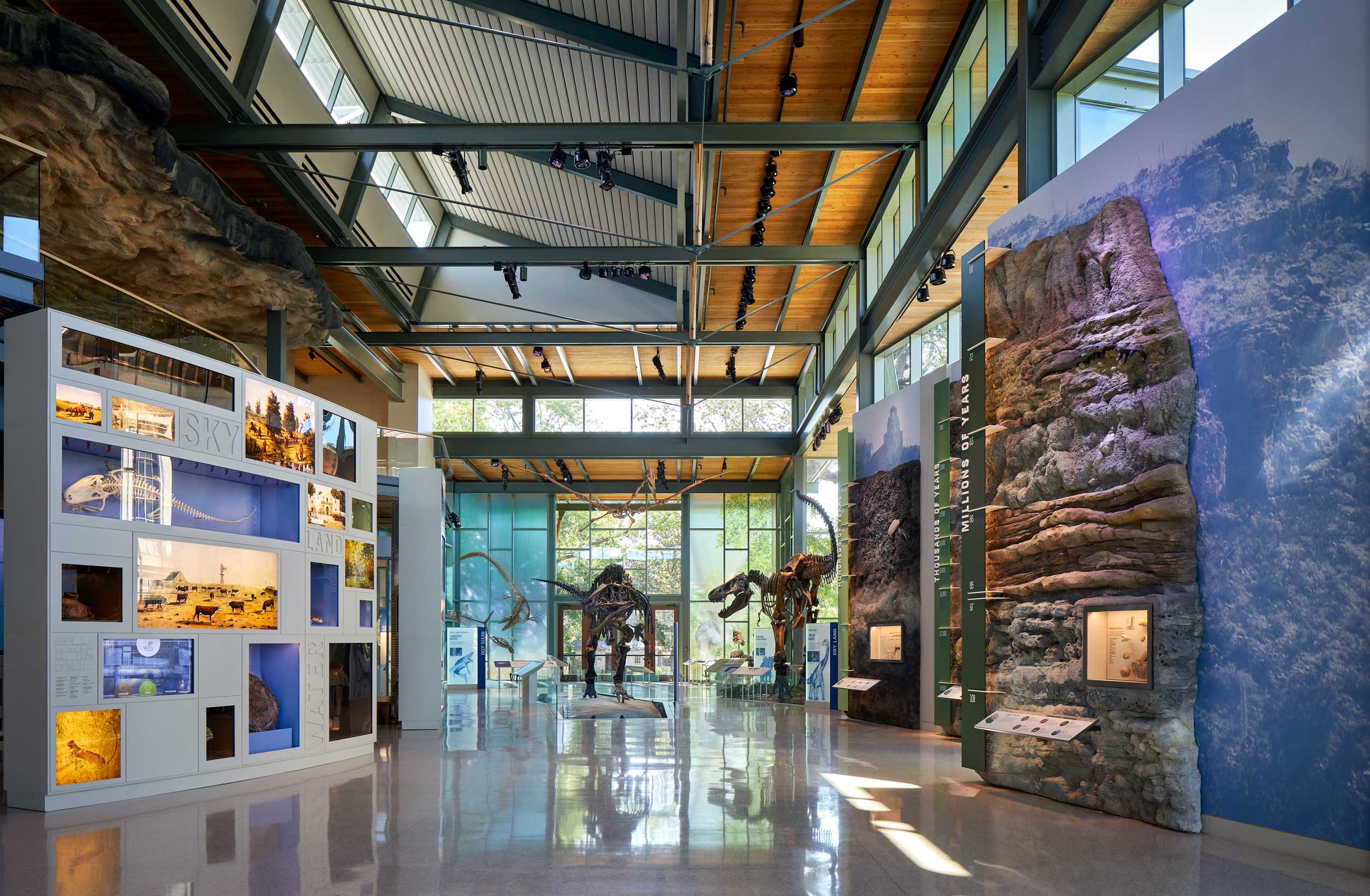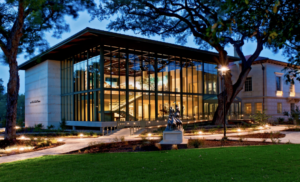The Witte Museum is located between the ancient San Antonio River and historic Broadway, a bountiful riverside campus with large and open galleries, where Nature, Science and Culture meet through the lens of what we call Texas Deep Time and the themes of Land, Sky and Water.
What does that mean? You will be immersed in the land, sky, and water inside and outside on the way to fully experiencing the place we now call Texas.
As the San Antonio River runs through the 10-acre campus, down from the headwaters nearby, you will witness millions, thousands and hundreds of years of history within the galleries and on the grounds. Petrified specimens from the Cretaceous era, artifacts from Archaic times and the 1719 Acequia Madre and Diversion Dam from the Spanish period are integrated into the wonders of the Witte.

The Witte Museum ensures that access to the museum, riverside habitat and the ever-growing collection are available to all. Through funding partnerships with multi-generational donors, the Witte hosts Free Tuesdays and is a proud supporter of the city’s Museums for All initiative.
Since the museum’s founding in 1926, the Witte welcomed visitors from throughout Texas and beyond, and became a trusted keeper of historic artifacts stories and artifacts and scientific specimens. Looking forward, we vow to always be a safe place for civic discourse so that challenges and differences can be discussed, engaged in and ultimately part of solutions for progress.
We hold ourselves accountable so that every person has an “Ah Ha” moment when exploring the Witte. The exhibitions, collections and programs of the Witte encourage the exploration of Texas, not only the land, water and sky, but also humanity and culture.
The Witte Museum is a primary-source content provider engaging K-12 students in innovative, Texas Essential Knowledge and Skills aligned curriculum, and inquiry-based learning experiences. The knowledge and experience through on-campus or digital programming is unique, exceptional and not replicable. “How do we know what we know?” is the foundation upon which the galleries, digital platforms and programs are created.
The Witte has a Texas State and Federally certified curatorial collection repository and labs in archeology, history, geology and paleontology. The Witte’s B. Naylor Morton Research and Collections Center and Collections Repository includes offices for Witte Curatorial and Collections teams and housing for 320,000 artifacts and specimens.
The Witte Museum stands on a platform of excellence as an American Alliance of Museum Accredited Museum. The standards set by AAM are rigorous, with museum best practices as foundational. Only 7% of museums nationally have earned accreditation, an elite status the Witte has maintained since 1974, with the most recent re-accreditation awarded in 2018. The Witte is committed to sustaining accreditation through consistent and progressive collections stewardship.
The Witte Museum adheres to its Mission to inspire people to shape the future of Texas through transformative and relevant experiences in nature, science and culture. The Witte’s Vision is to be the preeminent center for relevant content and engaging experiences in environmental science, STEAM, and cultural stories to shape the future of Texas by empowering all people to create an extraordinary life.
The Witte Team embraces life-long learning, ensuring that we continue to advance museum leadership, provide professional development and embrace diversity, inclusion and equity.
The Witte has launched Witte Where You Are, an online learning portal, with live-remote programs offered to teachers, school children and families. Given the success of Witte Where You Are, particularly during the COVID 19 pandemic, the Witte has quietly launched Texas Museums 360, which will provide digital platforms for Witte inquiry based content to school districts throughout Texas.
The Witte offers interpretive planning and exhibition services to community partners engaged in cultural innovations.
The Witte campus provides countless moments of wonder, from peering into animal dens under the earth to soaring dinosaur casts, from people creating earth ovens long ago to chili queens offering culinary delights on the plazas of San Antonio. Many of these experiences are the result of a $100 million renovation and expansion of the Witte Museum over ten years, from 2007 to 2017, when the “New Witte” fully opened, with 174,000 square feet of change. Led by visionary Board of Trustees and ambitious Witte Team, the New Witte opened to critical acclaim and community pride.
Marise McDermott was appointed as President and CEO of the Witte Museum in 2004 to usher in the new era of growth for the Witte Museum. Under McDermott the Witte Museum has made great strides in expanding the museum campus with a renewed focus on Texas.
In 2012 the Robert J. and Helen C. Kleberg South Texas Heritage Center opened in the historic Centennial building next to the original Witte Museum. The Center stands as a permanent home for exhibits of the history and art of Texas utilizing the latest museum practices and technology.
In 2014, the Witte, along with more than 100 medical, public health and education leaders, and with a powerful partnership with H-E-B, University Health System, Blue Cross Blue Shield, and San Antonio Children’s Hospital, led the transformation of the H-E-B Science Treehouse into the H-E-B Body Adventure Powered by University Health System. The H-E-B Body Adventure opened in 2014 as the first interactive health experience with POWERpass technology and data retrieval in the United States. The H-E-B Body Adventure won international and national awards and was a key reason the City of San Antonio won the Robert Woods Johnson Culture of Health Award in 2018.
The Witte also opened the B. Naylor Morton Research and Collections Center in 2014 to display the Witte’s iconic artifacts in visible storage, as well as offer space for scholars, archivists and school children to have close encounters with the still growing collection. The Witte also purchased an offsite collection repository that stores the 320,000 Witte’s artifacts and specimens. The Witte’s repository will also hold held-in-trust collections from state and federal excavations in archeology, paleontology and geology as a state and federally certified collections repository.
In 2016, the Mays Family Center opened serving as a multi-purpose exhibition and special events center spanning 19,000 square-feet. The Mays Family Center hosts major galas, non-profit fundraisers, weddings and other special events. During most summers, the Witte hosts major blockbuster exhibitions from around the world, such as those on the Maya, Whales and Dinosaurs. The Mays Family Center opens to the Zachry Family Acequia Garden along the San Antonio River, with an interpretive Diversion Dam and Acequia Madre inspired by the 1719 structures built by Spanish Friars and Texas Indians.
In 2017, the Susan Naylor Center opened, designed by Architects Lake Flato and with exhibitions designed by Gallagher and Associates. The New Witte architecture and galleries won numerous local and national awards. The Susan Naylor Center opens with the H-E-B Lantern into the Valero Great Hall and Gates Mineral Orientation Theater, and includes the Naylor Family Dinosaur Gallery, McLean Family Texas Wild Gallery and Kittie West Nelson Ferguson People of the Pecos Gallery, all with accompanying interactive learning labs for school children and families.
The successful $100 million capital campaign was Co-Chaired by Peggy Walker and Sam Dawson, along with Chairs of the Board of Trustees Ty Griesenbeck, Michael Bolner, Mark Metcalfe, Don Gonzales, JJ Feik and Dirk Elmendorf.
Now, with hundreds of thousands of school children and families flocking to the expanded campus annually, the Board of Trustees of the Witte Museum quietly launched a $100 million Witte Forever Campaign for endowment, capital and operating funding to ensure future excellence. After the 2020 COVID-19 pandemic impact, Witte leadership reframed the campaign to focus on $26 million in endowment funds by 2026, the 100th Anniversary of the Witte Museum.

The Witte Forever Campaign will ensure that the Witte sustains an outstanding museum professional team, including Curators, Educators, Designers and Engagers that ensure that programs and content are grounded in scholarship, relevant to the community and accessible to all audiences, while also maintaining the new centers, gardens and infrastructure for generations to come.
The power of the changing Texas story is what ensures that the Witte is forever, as the place where all people encounter what they can only learn in museums, with artifacts and specimens as evidence and with cultural narratives that change as people change. Like the layers of earch and rock that mark Texas Deep Time, the Witte must continually build on the past, planning, researching and creating new educational opportunities and developing powerful partners to thrive today and for many generations in the future.
The Witte encourages the exploration of Texas through innovative research, programming and partnerships and builds workforce readiness in nature, science and culture. Internships and field work opportunities in Paleontology and Geology provide hands-on experience working to preserve the oldest specimens found in Texas and the Land Stewardship Ambassadors program, in partnership with the East Foundation, empowers the next generation of environmental and civic leaders from across the state to advocate for the healthy future of Texas lands.
An institution that is the pride of Texas deserves no less than a bold vision and strong support to make that vision a reality.
The Witte was founded by school teacher and botanist Ellen Schulz Quillin. She began her goal of starting a museum for the growing city of San Antonio in 1923. With a desire for school children to have access to the natural world, she enlisted her students and the community to help raise funds to to acquire the H.P. Attwater natural history collection. She enlisted the help of community leaders, including Lena McAllister, Ethel Drought and Mayor John Tobin, to form the San Antonio Museum Association. The natural history was installed at Main Avenue High School on October 8, 1923 and the search for a museum location was launched.
During a period that can be considered a fundraising and awareness campaign, San Antonio businessman Alfred G. Witte died September 22, 1925, leaving $65,000 to fund a museum in Brackenridge Park. The gift was unexpected but the members of the San Antonio Museum Association quickly went to work with Mayor Tobin and Architect Robert Ayers on the new museum named for Witte’s parents. The City of San Antonio matched the bequest with an additional $65,000. A museum site was chosen at the first bend of the San Antonio River and as the third entrance to the Park, along River Avenue, now Broadway. The Witte Museum opened just over a year later to a huge community celebration on October 8, 1926 and today boasts of being the first major museum in Texas.
Through the late 1920s and 1930s Ellen Schulz Quillin worked for a dollar-a-year salary and managed a total operating budget of $100. While always short of funds, the museum grew rapidly adding paintings and historical artifacts. The Witte led expeditions throughout Texas, finding and memorializing Rock Art paintings and artifacts from the first people, building relationships with the state’s ranchers and farmers, and documenting the diverse flora and fauna of the state.
Contributors to the collection knew that they had been through a remarkable period of Texas history and generously gave items to the Witte so that future generations would understand their past. The early collection additions included some of the most important pieces in the now vast Witte holdings.
Both the San Antonio Art League and the San Antonio Conservation Society operated out of the Witte Museum. Throughout the 1930s, the Witte Museum became a gathering place for artists, researchers, scholars, and the general community. To raise money, dances, chuck wagon dinners, and classes on a number of subjects, including art classes, became increasingly popular.
Eleanor Onderdonk joined the Witte staff in 1927 as the Curator of Art spearheading the Museum School of Art and the growth of the Witte’s Texas Art Collection. Some of the most popularity instructional classes were led by some of the most important artists in the area, including , Julius Woeltz, Octavio Medellin, Xavier Gonzales, Ruby Dugoshand Harding Black. The art classes continued for decades eventually transitioning into the San Antonio Art Institution 1942. Some now well-known Texas artists, like Jesse Treviño, took their first art lessons at the Witte Museum.
During the 1930s, the Witte began supporting archeological research in the canyons of the Lower Pecos area and the almost inaccessible areas of the Big Bend. The pioneering expeditions were led by the Southwest Texas Archeological Society with support and staffing from the Witte Museum. The efforts led to the building of new galleries at the Witte and expanded financial support, important research findings and additions to the collections, now the finest of their kind in the world.
Faced with the Great Depression in the 1930s and dwindling funds, Quillin came up with an innovative plan to build the popular Reptile Garden. A reported 800 visitors attended opening day, paying ten cents each to see the program. A professional herpetologist demonstrated milking rattlesnakes in the outdoor facility and did continuing research to develop an anti-venom serum. Fried rattlesnake was also served at the Reptile Garden and the Rattlesnake Dinners continued as an annual fundraising event for sixteen years.
Three historic structures were added to the Witte Museum campus in the 1940s. The first, in 1941, was the riverside home of early San Antonio businessman and banker John Twohig. When Quillin and her supporters found the limestone house was scheduled for demolition they secured funds to dismantle the two-story structure and move it to a new riverside location behind the Witte Museum. The Twohig building is listed in the National Register as a contributing structure to the Brackenridge Park National Historic District. The second building to be moved was the first public school house in San Antonio that was in use in 1801. The owner was José Francisco Ruiz, one of two Tejanos to sign the Texas Declaration of Independence. The house, made from plastered stone, was carefully reconstructed on the Witte Museum grounds in 1943.
The home of Celso Navarro was the third historic building moved to the Witte Museum campus. Angel Navarro, ancestor of the owner, was an immigrant from Corsica in 1731 and became the Spanish Alcade, or mayor, of San Antonio in 1790. The house, constructed of plastered cut limestone was moved to the Witte campus in 1948.
Two log cabins were built on the Witte campus during the 1940s to show how Texans lived in the 1800s. They were furnished and used in educational programs. One continues to be accessible to visitors today.
The 1960s marked a major change for the Witte Museum. Quillin worked with designers to increase the size of the Museum by 60 percent and to create a new modern entry. The “modern” Witte Museum was dedicated in November of 1960. Shortly after the opening, founding Director Ellen Schulz Quillin retired, assured that the Witte Museum was strongly situated with fine collections and a bright future.
The Museum once again expanded with improved art galleries and historic exhibits in the 1960s. The McFarlin Jewel Room opened in 1961, and the Piper Wing was opened in 1962.
Through the 1970s an important focus on decorative arts was laid by longtime Curator Cecilia Steifeldt. Steinfeldt curated exhibitions and wrote several important books “Early Texas Furniture and Decorative Arts” and “Texas Folkart-One Hundred Years of the Southwestern Tradition.”
Also in the 1970s, one of the Witte Museum’s most important galleries was opened, the Lone Star Hall of Wildlife and Ecology. This gallery laid the foundation for the Witte’s beloved Texas Wild exhibit which features four of the original dioramas.
In 1970, under the umbrella of the San Antonio Museum Association, a separate San Antonio Museum of Art was opened in the renovated Lone Star Brewery also on the San Antonio River, like the Witte Museum. The larger space allowed curators and a new Director to expand the art collection, including American, European, Spanish Colonial and Mexican, as well as Asian.
Both the Witte Museum and the San Antonio Museum, with separate Directors, operated under the San Antonio Museum Association until the 1990s.
Through the next thirty years the Witte Museum brought in numerous traveling exhibits and also created small exhibitions to share with small Texas museums, including Art for History’s Sake: The Texas Collection of the San Antonio Museum Association, God, Gold & Glory: Conquistadors in North America, Stone to Steel: The World of Arms and Armor, Indians of the Plains: A Flash of Glory, Rites of Passage and Water, Wind, Breath: Exploring Southwester Indian Symbolism. Several major exhibitions were added to the Witte Museum, including Ancient Texans, installed in the 1980s.One of the most popular Witte Museum exhibits was the Dinosaurs: Vanished Texans, which introduced “Herb” the Triceratops which opened in 1983.
In 1989, the San Antonio Museum Association agreed to allow the San Antonio Museum of Art to form its own entity, with focus on world art, including Roman, Egyptian and Modern American Art Galleries. The two museums officially separated in 1994, but continue to be enduring colleagues along the Broadway Cultural Corridor.
The Witte Museum, the founding museum for the Association, continued its focus on major traveling exhibitions, as well as focused work on regional history, art and Texas natural history and science, with growing collections and education programs.
The 1990s saw a further renaissance for the Witte Museum. Under the leadership of Witte Director Mark Lane and Curator Bruce Shackelford, the exhibition, Thundering Hooves: 500 Years of Horse Culture in the Americas, opened at the Witte to critical acclaim in 1994. The exhibition traveled throughout the United States. With that exhibition, the gallery theater program was initiated, including Vaquero Y Cowboy and the Longhorn Connection.
The H-E-B Science Treehouse opened in the 1997 creating a science center for the ever-growing numbers of school children visiting the Witte under the direction of Director of Public Programs Mimi Quintanilla. Interactive exhibits demonstrating basic science and physics were installed in a structure designed by Lake Flato looking over the San Antonio River.
During this time, the Quillin Society was created, a donor level support group that continues to provide tremendous support for the Witte. Mark Lane also founded the Humanities Center, bringing aboard Marise McDermott as Director of the Center, which offered hands-on, artifact and archives based programs and eventually expanded to include Elderhostel, with people coming from throughout the United States to experience humanities programs focused on San Antonio and Texas history.
WITTE MUSEUM and all related brands are ® & ™ the Witte Museum.
© 2023 The Witte Museum, San Antonio, Texas
The Witte Museum
Nature, Science & Culture
3801 Broadway
San Antonio, Texas 78209
Phone: 210.357.1900
Contact the Witte Museum



